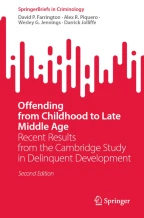Self-Reported Versus Official Offending

Other than official data, self-report data is the second-most utilized source for information on offending. Recognizing the inherent limitations of official and self-report data in terms of sources for crime measurement, this chapter provides an in-depth exploration into the prevalence and frequency of offending among the CSDD males with a specific focus on the similarities, differences, and overlap across offending estimates from the two crime data sources (official versus self-report). The ratio of self-reported to official offenses is also reviewed and disaggregated by offense type.
This is a preview of subscription content, log in via an institution to check access.
Access this chapter
Subscribe and save
Springer+ Basic
€32.70 /Month
- Get 10 units per month
- Download Article/Chapter or eBook
- 1 Unit = 1 Article or 1 Chapter
- Cancel anytime
Buy Now
Price includes VAT (France)
eBook EUR 42.79 Price includes VAT (France)
Softcover Book EUR 52.74 Price includes VAT (France)
Tax calculation will be finalised at checkout
Purchases are for personal use only
References
- Blumstein, A., Cohen, J., Piquero, A. R., & Visher, C. A. (2010). Linking the crime and arrest processes to measure variations in individual arrest risk per crime (Q). Journal of Quantitative Criminology, 26, 533–548. ArticleGoogle Scholar
- Cohen, M., & Piquero, A. (2009). New evidence on the monetary value of saving a high-risk youth. Journal of Quantitative Criminology, 25, 25–49. ArticleGoogle Scholar
- Farrington, D. P. (1973). Self-reports of deviant behavior: Predictive and stable? The Journal of Criminal Law and Criminology, 64, 99–110. ArticleGoogle Scholar
- Farrington, D. P. (1989). Self-reported and official offending from adolescence to adulthood. In M. W. Klein (Ed.), Cross-national research in self-reported crime and delinquency (pp. 399–423). Kluwer. ChapterGoogle Scholar
- Farrington, D. P., & Jolliffe, D. (2004). England and Wales. In D. P. Farrington, P. A. Langan, & M. Tonry (Eds.), Cross-national studies in crime and justice (pp. 1–38). Bureau of Justice Statistics. Google Scholar
- Farrington, D. P., & Koegl, C. J. (2015). Monetary benefits and costs of the Stop Now And Plan program for boys aged 6–11, based on the prevention of later offending. Journal of Quantitative Criminology, 31, 263–287. ArticleGoogle Scholar
- Farrington, D. P., Loeber, R., Van Stouthamer-Loeber, M., Kammen, W. B., & Schmidt, L. (1996). Self-reported delinquency and a combined delinquency seriousness scale based on boys, mothers, and teachers: Concurrent and predictive validity for African-Americans and Caucasians. Criminology, 34, 493–517. ArticleGoogle Scholar
- Farrington, D. P., Jolliffe, D., Hawkins, J. D., Catalano, R. F., Hill, K. G., & Kosterman, R. (2003). Comparing delinquency careers in court records and self-reports. Criminology, 41, 933–958. ArticleGoogle Scholar
- Farrington, D. P., Jolliffe, D., Loeber, R., & Homish, D. L. (2007). How many offenses are really committed per juvenile court offender? Victims and Offenders, 2, 227–249. ArticleGoogle Scholar
- Hindelang, M. J., Hirschi, T., & Weis, J. G. (1981). Measuring delinquency. Sage. Google Scholar
- Huizinga, D., & Elliott, D. S. (1986). Reassessing the reliability and validity of self-report delinquency measures. Journal of Quantitative Criminology, 2, 293–327. Google Scholar
- Jolliffe, D., & Farrington, D. P. (2014). Self-reported offending: Reliability and validity. In G. J. N. Bruinsma & D. Weisburd (Eds.), Encyclopedia of criminology and criminal justice (pp. 4716–4723). Springer. ChapterGoogle Scholar
- Jolliffe, D., Farrington, D. P., Hawkins, J. D., Catalano, R. F., Hill, K. G., & Kosterman, R. (2003). Predictive, concurrent, prospective and retrospective validity of self-reported delinquency. Criminal Behaviour and Mental Health, 13, 179–197. ArticleGoogle Scholar
- Junger-Tas, J., & Marshall, I. H. (1999). The self-report methodology in crime research. In M. Tonry (Ed.), Crime and justice (Vol. 25, pp. 291–367). University of Chicago Press. Google Scholar
- Krohn, M. D., Thornberry, T. P., Gibson, C. L., & Baldwin, J. M. (2010). The development and impact of self-report measures of crime and delinquency. Journal of Quantitative Criminology, 26, 509–525. ArticleGoogle Scholar
- Loeber, R., Farrington, D. P., Stouthamer-Loeber, M., & White, H. R. (2008). Violence and serious theft: Development and prediction from childhood to adulthood. Routledge. Google Scholar
- Piquero, A. R., Jennings, W. G., & Farrington, D. P. (2013). The monetary costs of crime to middle adulthood: Findings from the Cambridge Study in Delinquent Development. Journal of Research in Crime and Delinquency, 50, 53–74. ArticleGoogle Scholar
- Raffan Gowar, B., & Farrington, D. P. (2013). The monetary cost of criminal careers. In K. Boers, T. Feltes, J. Kinzig, L. W. Sherman, F. Streng, & G. Trueg (Eds.), Kriminologie, kriminalpolitik, strafrecht (Criminology, crime policy, penal law): Festschrift fur Hans-Jurgen Kerner on the occasion of his 70th birthday (pp. 441–456). Mohr Siebeck. Google Scholar
- Theobald, D., Farrington, D. P., Loeber, R., Pardini, D. A., & Piquero, A. R. (2014). Scaling up from convictions to self-reported offending. Criminal Behaviour and Mental Health, 24, 265–276. ArticleGoogle Scholar
- Thornberry, T. P., & Krohn, M. D. (2000). The self-report method for measuring delinquency and crime. In D. Duffee (Ed.), Criminal Justice 2000 (Vol. 4, pp. 33–84). US National Institute of Justice. Google Scholar
Author information
Authors and Affiliations
- Institute of Criminology, Cambridge University, Cambridge, UK David P. Farrington
- Department of Sociology and Criminology, University of Miami, Coral Gables, FL, USA Alex R. Piquero
- Department of Criminal Justice and Legal Studies, University of Mississippi, University, MS, USA Wesley G. Jennings
- School of Law and Criminology, University of Greenwich, London, UK Darrick Jolliffe
- David P. Farrington

